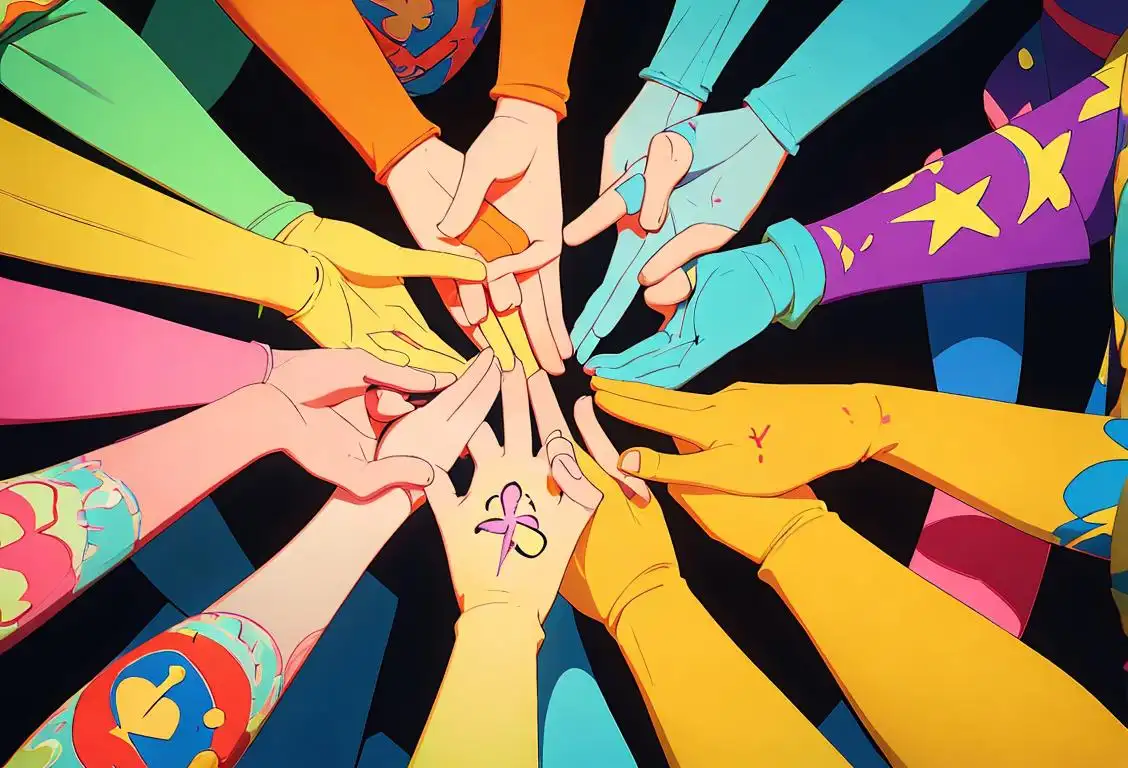National Sapphic Day

Welcome to the fantastic world of National Sapphic Day! This is a day dedicated to celebrating love, friendship, and the vibrant sapphic community. Prepare yourself for a delightful journey through the internet history of this special day.
When is Sapphic Day?
It's national sapphic day on the 1st September.
A Brief Overview of National Sapphic Day
Every year on September 1st, the internet buzzes with excitement as people around the world come together to honor and appreciate the experiences and contributions of sapphic women. National Sapphic Day is a time to recognize the beauty of sapphic love and to embrace the diversity of relationships within the LGBTQ+ community.
Though there isn't an official origin story for National Sapphic Day, the power of the internet is evident in its widespread popularity. Social media platforms have played a significant role in spreading awareness and promoting the celebration of this special day. From heartfelt messages to stunning creative expressions, the internet has become a hub of positivity during this annual event.
While National Sapphic Day is rooted in celebrating relationships and love between sapphic women, it's also a day to appreciate the broader sapphic community. This includes lesbians, bisexual women, pansexual women, and others who identify within this vibrant spectrum. It's a day to uplift their voices, honor their stories, and recognize their contributions to society.
How to Celebrate National Sapphic Day
Celebrating National Sapphic Day is all about spreading love and support. Here are a few ideas to help you get started:
- Host a virtual gathering or party with your loved ones to exchange stories and experiences.
- Show your support by donating to organizations that provide resources and advocacy for the sapphic community.
- Share empowering messages or stories on social media using the hashtag #NationalSapphicDay.
- Take the time to educate yourself on the historical context and struggles faced by sapphic women throughout history.
- Reach out to a sapphic friend and let them know how much you appreciate and support them.
Did You Know?
Did you know that September 1st is also celebrated as World Letter Writing Day? So not only can you express your love and appreciation for the sapphic community, but you can also send a heartfelt letter to a loved one! It's all about spreading joy and celebrating connections.
History behind the term 'Sapphic'
570 BCE
Ancient Greek poet Sappho emerges
Sappho, an Ancient Greek poet from the island of Lesbos, gained immense popularity during her era for her lyrical poetry and musical compositions. She explored themes of love, desire, and beauty in her works, often focusing on her relationships with other women. Sappho's intimate and passionate verses laid the foundation for the term 'sapphic' to later become associated with same-sex desire and female friendships.
630 BCE
The Life of Sappho
Sapphic comes from the name of the ancient Greek poetess, Sappho, who lived on the island of Lesbos during the 7th century BCE. Sappho is considered one of the greatest lyric poets of ancient Greece, known for her emotional and passionate poetry. She wrote frequently about love and desire, often expressing her affections for other women. Sappho's work played a significant role in shaping the understanding and acceptance of same-sex love, both in her time and for generations to come.
600 BC
The Origin of Sapphic
The term 'Sapphic' originates from the Greek poet Sappho, who lived on the island of Lesbos around 600 BC. Sappho was a highly respected poetess, known for her emotional and passionate love poems, often expressing love and desire for women. Her poetry celebrated female beauty and relationships, providing a platform for the exploration of same-sex love in ancient Greece.
6th century BCE
Origin in Ancient Greece
The term 'Sapphic' originates from the Ancient Greek poet Sappho, who lived on the island of Lesbos during the 6th century BCE. Sappho was well-known for her poetry, particularly her love poems addressed to women, which were considered passionate and emotionally intense. Sappho's work celebrated love and desire between women, giving rise to the term 'Sapphic' to describe same-sex love or desire.
6th Century BCE
Birth of Sappho
Sapphic is derived from the Greek poet Sappho, who lived on the island of Lesbos during the 6th century BCE. Sappho wrote lyrical poetry, often expressing love and desire between women. Though only fragments of her work survived, her verses became known as 'Sapphic' and influenced generations of poets and scholars.
1890 CE
Sapphic revived by poets and scholars
During the late 19th century, the term 'sapphic' experienced a revival through the work of poets and scholars. Inspired by Sappho's poetry, writers like Pierre Louÿs and Renée Vivien explored similar themes of same-sex desire and female love in their own works. As these authors gained recognition and their works became more widely read, the term 'sapphic' began to gain momentum and take on its own distinct meaning in literary and cultural circles.
17th century CE
Influence on Female Homoerotic Literature
During the 17th century, the term 'Sapphic' gained prominence in literary circles to describe female homoeroticism. It was used to refer to poetry, prose, and artwork that depicted same-sex love or desire between women. The influence of Sappho's original work on subsequent generations of writers and artists made 'Sapphic' a widely recognized term within the context of lesbian literature.
1890
The 'Sapphic' As a Literary Term
In the late 19th century, the term 'Sapphic' began to be used as a literary term to refer to works that focused on female same-sex love or desire. Poems, novels, and plays with lesbian themes were often described as 'Sapphic', drawing inspiration from Sappho's own writings and the romanticized view of her relationships. This usage helped establish 'Sapphic' as a term associated with same-sex love in literature.
circa 1746
Sapphic in English
The term 'Sapphic' first appeared in English during the mid-18th century, specifically around 1746. It was used to describe the poetry and literary style that resembled or imitated Sappho's works. During this period, Sapphic poetry gained popularity among English writers, who admired and sought to emulate her emotional, personal, and intimate language in their own verses. The term 'Sapphic' became a way to classify and identify this specific poetic style that mirrored the themes and structure found in Sappho's original writings.
19th Century
Rediscovery of Sappho's Work
During the 19th century, the works of Sappho, previously lost or unknown, were discovered on papyrus fragments and referenced in ancient writings. These rediscoveries led to a surge of interest in Sappho's poetry and the themes of desire and love between women explored in her verses.
Late 19th Century
Sapphism and Female Same-Sex Desire
During the late 19th century, the term 'Sapphic' began to extend beyond just a poetic style. It started being associated with female same-sex desire and relationships, as well as a broader concept of female homosexuality. This connection between Sappho and same-sex desire stemmed from the historical understanding of Sappho's own inclinations and works. Sappho's fame and association with affection between women allowed the term 'Sapphic' or 'Sapphism' to become a way to refer to lesbianism and lesbian identity.
Late 20th Century
Sapphic As an Identity
In the late 20th century, the term 'Sapphic' gained popularity as an identity term among lesbian women. It became a way for women attracted to other women to express their sexual orientation and embrace their connection to Sappho's legacy. 'Sapphic' came to signify not only same-sex desire in literature but also a personal and cultural identification for lesbian individuals, emphasizing their connection to a rich history of love and expression.
19th century CE
Emergence of the Term 'Sapphism'
In the 19th century, the term 'Sapphism' emerged as a synonym for 'Sapphic'. It further cemented the connection between same-sex desire and the legacy of Sappho. This term entered mainstream discourse and was used in medical, psychological, and legal contexts when discussing same-sex attraction and relationships between women.
1894
Coined Term 'Sapphic'
The term 'Sapphic' was coined in 1894 by the poet and scholar Havelock Ellis. Ellis derived the term from the association with Sappho and her lyrical poetry, specifically focusing on the homoerotic nature of her verses. 'Sapphic' became a descriptor for women-loving-women, both in literary and broader contexts.
20th century
Sapphic as a synonym for lesbian
As the concept of homosexuality gained visibility and acceptance in the 20th century, the term 'sapphic' emerged as a synonym for lesbian or same-sex female desire. It captured the essence of women who loved women, drawing on Sappho's historical significance and her representation of love between women. The term found its place not only in literary contexts but also in broader discussions of sexuality and identity.
20th Century
Sapphic in Modern Context
In the 20th century, the term 'Sapphic' continued to evolve and solidify its place in the English language. It became a common adjective used to describe women who are attracted to other women, whether in romantic or sexual contexts. 'Sapphic' is often utilized in literary, academic, or artistic circles to express same-sex desire or to refer to works of art, literature, or music that explore lesbian themes. The term has become an integral part of LGBTQ+ vocabulary, serving as an inclusive and affirming descriptor for women who identify as lesbian or have same-sex attractions.
Modern Times
Sapphic As a Cultural and Linguistic Symbol
In modern times, 'Sapphic' has evolved beyond its original literary and identity contexts. The term has become a cultural shorthand for women loving women and is often used to describe anything related to lesbian relationships, desires, or experiences. It is utilized in various forms of art, media, and popular culture to represent lesbian and queer communities. 'Sapphic' has encompassed a broad range of meanings and continues to serve as a symbol for lesbian pride and visibility.
20th Century
Sapphic Themes in Literature
In the 20th century, literature began to explore Sapphic themes more openly. Many notable writers, including Virginia Woolf and Radclyffe Hall, addressed lesbian desire and relationships in their works. The influence of Sappho's poetry and the term 'Sapphic' continued to shape the representation of queer women within the literary canon.
20th century CE
Recognition and Celebration of Sapphic Identity
In the 20th century, 'Sapphic' gained recognition as a term to describe women who were attracted to other women and identified as lesbians. It became an integral part of LGBTQ+ culture, literature, and activism. The term 'Sapphic' celebrates and acknowledges the historical and cultural significance of Sappho's work, as well as the diverse experiences and identities of lesbian and queer women.
1979 CE
Sapphic Pride
The term 'Sapphic' further gained prominence during the rise of the feminist and LGBTQ+ movements in the late 20th century. 'Sapphic' Pride became a celebration of lesbian and queer women, acknowledging their visibility and contributions to various fields including literature, art, and activism. Sapphic-themed events, organizations, and publications emerged, creating spaces for women to express their identities and find solidarity within the community.
Contemporary Era
Sapphic Identity and Empowerment
In the contemporary era, the term 'Sapphic' has evolved to encompass identity and empowerment for women who love women. It serves as a positive and inclusive term for lesbian, bisexual, and queer women. 'Sapphic' has found resonance within the LGBTQ+ community, representing a rich history of love, desire, and creativity.
Present Day
Sapphic resonates in popular culture
In the present day, the term 'sapphic' continues to resonate in popular culture, both as an academic term and in everyday language. It has become a way for people to express their same-sex desires, attractions, or relationships with a historical and poetic flair. 'Sapphic' is used in literature, music, and various forms of media to celebrate and affirm the experiences of lesbian, bisexual, and queer women, honoring the legacy of Sappho and the rich history associated with the term.
Did you know?
Did you know that September 1st is also celebrated as World Letter Writing Day?Tagged
awareness fun loved onesFirst identified
1st September 2020Most mentioned on
1st September 2020Total mentions
4Other days
Compliment Day
Cheese Pizza Day
Pumpkin Day
Medal Of Honor Day
Guac Day
Foundation Day
Suicide Prevention Day
Memorial Day
Cancer Survivors Day
Bacon Day









